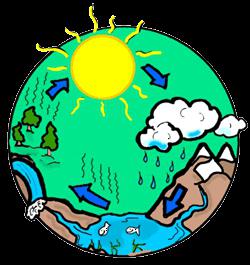The water cycle in nature, also known as the hydrological cycle, describes the continuous movement of water on the surface of the Earth, as well as above and below it. Although the water balance on Earth remains virtually unchanged over time, individual water molecules can enter and leave the atmosphere. Water moves, for example, from a river to the ocean or from the ocean to the atmosphere through physical processes such as evaporation, condensation, precipitation, infiltration, runoff, as well as through underground currents. In this case, water passes through various phases: liquid, solid (ice) and gaseous (steam).

The water cycle in nature involves heat transfer, which leads to temperature changes. For example, when water evaporates, it draws heat from the environment and cools it. When it condenses, it gives off heat and heats the environment. This heat transfer affects the climate. The water cycle in nature is also associated with geological processes on Earth (erosion and sedimentation). And finally, thanks to him, the life and stability of ecosystems on Earth is maintained.
Description
The water cycle in nature for children begins to be described even in the elementary grades, so everyone knows that the sun, through which it occurs, heats water in the oceans and seas. Water evaporates and enters the air in the form of steam. Ice and snow can sublimate directly into water vapor, bypassing the liquid phase. The evaporation of water from plants and soil also occurs.
The ascending air flows lift the vapor into the atmosphere, where low temperatures cause it to condense into clouds. Air currents carry water vapor around the world, clouds collide, grow and water falls from the upper atmosphere in the form of precipitation. Some of them can accumulate in the form of ice caps and glaciers that retain frozen water for thousands of years. Most of the water flows back into the oceans or land as rain, forming a surface runoff. Part of the runoff flows into rivers, and from there into the seas and oceans. Storm and groundwater are partially collected in freshwater lakes. However, most of it is absorbed into the earth and infiltrated: it penetrates deep into the earth and replenishes the aquifers, which are reservoirs of fresh water. Such horizons can be located close to the surface, and water can seep back - this is how springs are formed. However, over time, water returns to the ocean, where it all began.
The processes due to which the water cycle in nature occurs:
Precipitation
Most precipitation falls in the form of rain. Other types: snow, hail, fog, groats and wet snow. About 505,000 km³ of water falls in the form of precipitation annually.
Precipitation interception
Precipitation that has been intercepted by the foliage of the plants eventually evaporates back into the atmosphere, rather than falling to the ground.
Melt water
Stoke from melting snow.
Stock
Various ways in which water moves on the ground. This can be both surface runoff and underground. Water can seep into the ground, evaporate into the air, be stored in lakes and reservoirs, or used for agricultural and other purposes.
Infiltration
Seepage of water from the surface into the ground.
Underground streams
The flow of water underground in the aeration zone and aquifers. Groundwater can return to the surface or eventually seep into the ocean. Groundwater tends to move slowly and replenish slowly, so that they can remain in aquifers for thousands of years.
Evaporation
The transformation of water from a liquid to a gaseous state, in which it moves from the surface of the earth or water bodies to the atmosphere. The source of energy for evaporation is primarily solar radiation. The total amount of evaporation is about 505,000 km³ of water per year.
Sublimation
Transition directly from the solid phase (snow or ice) to water vapor.
Deposition
This is the conversion of water vapor directly into ice.
Advection
The movement of water - in solid, liquid or gaseous state - through the atmosphere.
Condensation
The conversion of water vapor into liquid droplets of water in the air, the formation of clouds and fog.
Evaporation
The release of water vapor from plants and soil into the air.
Seepage
The flow of water horizontally through the soil and rocks under the influence of gravity.
The water cycle in nature is due to solar energy. 86% of global evaporation occurs from the surface of the ocean.
The water cycle in the biosphere is a biogeochemical cycle, because effluents are responsible for almost all movements of eroded sediments and phosphorus from land to water bodies.